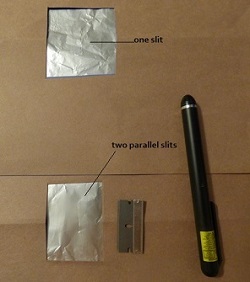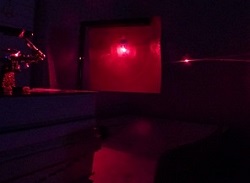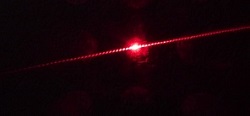Wave-particle Duality
"Light and matter are both single entities, and the apparent duality arises in the limitations of our language." [Heisenberg]
Paradox of wave-particle duality:
How can light show properties of a particle and a wave?
The concept of light being both a wave and particle at the same time (a paradox) is the foundation quantum mechanics was built on. English scientist Thomas Young challenged the existing theory (Isaac Newton's) that light is a particle. In an effort to verify the properties of light, Thomas Young created the double-slit light experiment during the early 1800s.
|
"But what is light really? Is it a wave or a shower of photons? There seems no likelihood for forming a consistent description of the phenomena of light by a choice of only one of the two languages. It seems as though we must use sometimes the one theory and sometimes the other, while at times we may use either. We are faced with a new kind of difficulty. We have two contradictory pictures of reality; separately neither of them fully explains the phenomena of light, but together they do". [Albert Einstein and Leopold Infeld, The Evolution of Physics, pg 262-263] |
To view interference patterns (evidence of waves), one 2 inch by 2 inch square is cut in the middle of a piece of thick paper (opaque, construction paper).
A second piece of thick paper (opaque, construction paper) has a 2 inch by 2 inch square cut out.
Two large squares of aluminum foil cover the squares.
The foil is taped to the paper, covering the holes.

A razor blade cuts a 1 inch slit in the center of the aluminum foil on the first.
On the second, 2 razor blades, held together, cut 2 parallel slits (1 inch in length) in the center.

Laser light shines through the slit in the first paper. The reflective side of aluminum foil faces away from the laser.


When light shines through the double-slit, interference patterns are observed.



Interference patterns are visible. Light is showing properties of a wave. Interference patterns are the distinct bands of color separated by dark regions. The interference patterns happen when light travels as a wave.
Atoms, electrons, photons exhibit a wave-particle duality. Is the electron or photon a particle or a wave? Or is it BOTH - a wave-particle duality?
If photons behave as waves, one photon at a time can be sent through the double-slit to confirm. Wrong. When a single(?) photon is fired through the double-slit, interference patterns continue to be observed. The single photon creates interference patterns with itself. The behavior uncovers a fundamental truth of quantum mechanics. In a wave-form state, quantum objects exist in a probability state.
The photon will "probably" travel through either slit at any given time (Schrodinger's Probability Equation). The wave-form ends up as a particle (waveform collapsing) when it hits the wall.
Fundamental elements of matter pop in and out of existence through probability states.
During the "which-way" experiment, scientists started to measure probability states as photons travel through each slit. The "which-way" detector attempts to measure (or observe) the trajectory of each particle to determine which slit the particle will pass through.
The result shocked the science community because the "act of measuring/observing" causes the collapse of the waveform and results in 2 lines. By measuring or observing the particles with a detector, no interference patterns were observed. The act of measuring causes the waveform to collapse. The particle exists as a "probability wave" but becomes a distinct particle as soon as it is measured. What constitutes observation or measurement and why? How does conscious measurement or observation change the nature of matter?

John Archibald Wheeler created the "delayed-choice" experiment that could change a barrier from one slit to two slits while the particle is in transit. By changing the structure of the second slit, it altered the behavior of the particle at the first slit. An observation gathered from the delayed-choice experiment:
Future events change the present.
Observations made in quantum experiments: 1. Fundamental elements of matter pop in and out of existence through probability states. 2. Future events change the present. |
On the topic of the future changing the present and "time", we recognize time is not an absolute. Specifically, time and position are not as absolute as once assumed. Newton's laws of motion discredit absolute position in space. Einstein's theory of relativity discredits absolute time. The warping of time, or the time dilation effect, comes from the nature of spacetime.
"Time and space are now seen as dynamic quantities with each individual particle, or planet, having its own unique measure of time depending on where and how each is moving." [The Illustrated A Brief History of Time, by Stephen Hawking]
Between gravitational time dilation and relative velocity time dilation, discrepancy in time can (and does) occur between humans and machines in space versus humans and machines on earth.
Gravitational Time Dilation "Another prediction of general relativity is that time should appear to run slower near a massive body like the earth. This is because there is a relation between the energy of light and its frequency (that is, the number of waves of light per second): the greater the energy, the higher the frequency. As light travels upward in the earth's gravitational field, it loses energy, and so its frequency goes down. ... This prediction was tested in 1962, using a pair of very accurate clocks mounted at the top and bottom of a water tower. The clock at the bottom, which was nearer the earth, was found to run slower, in exact agreement with general relativity. The difference in the speed of clocks at different heights above the earth is now of considerable practical importance, with the advent of very accurate navigation systems based on signals from satellites. If one ignored the predictions of general relativity, the position that one calculated would be wrong by several miles!" [The Illustrated A Brief History of Time, Stephen Hawking] |
Relative Velocity Time Dilation
During the Hafele and Keating experiment, airplanes carrying atomic clocks flew around the world. The resulting discrepancy between ground clocks and plane clocks was reported in nanoseconds. The faster the velocity, the greater the time dilation.
Exemplified in the video, relative velocity time dilation or "time travel" is possible.
Observations collected during quantum experiments are spooky.
One new theory for a new photon model suggests the photon consists of two particles.
| English | Spanish | ||||||
Mr. Victor Manuel Urbina Bolland, Technical Director of the Mexican company Química Foliar S.A. de C.V., was dedicated to the development and manufacture of high-quality fertilizers. Mr. Urbina dedicated a good part of his professional effort to the development of a new theory that correctly explains the electromagnetic light phenomenon by contemplating a new photon model. The proposal of the new photon model is supported through various experiments with theoretical and practical results. It better explains the nature of light when compared to current models. He developed two main experiments using a microwave equipment with a frequency of 10.5 gigahertz with a Gunn oscillator diode that produces a low-power and a very coherent radar beam. Results obtained suggest the photon consists of two particles. |
El Ing. Víctor Manuel Urbina Bolland es Director Técnico de la empresa mexicana Química Foliar S.A. de C.V., dedicada al desarrollo y fabricación de fertilizantes de alta calidad. El Ing. Urbina ha dedicado una buena parte de su esfuerzo profesional, al desarrollo de una nueva teoría que explique correctamente el fenómeno electromagnético de la luz mediante el concepto de un nuevo modelo de fotón. La propuesta de este nuevo modelo de fotón, se soporta mediante varios experimentos y resultados teóricos y prácticos, que explican mejor la naturaleza de la luz, si se comparan con los modelos aceptados actualmente. Desarrolló dos experimentos principales utilizando un equipo de microondas con una frecuencia de 10.5 gigahertz con un diodo oscilador Gunn, que produce un rayo de radar de baja potencia y muy coherente. Los resultados obtenidos sugieren que el fotón está constituido por dos partículas. |
Misc. links
Faraday's law
Holographic Principle
Maxwell's equations
Metamaterials
Metamaterial cloaking
Copyright © Oproot Research. All rights reserved.
Permission is granted for limited, non-commercial use of text and images. If used, please credit and notify Oproot Research. If circumstances permit, please include the URL: http://oproot.com. Oproot Research would appreciate a copy of publication. High-resolution images are also available. Please email requests, comments to tech@oproot.com.

